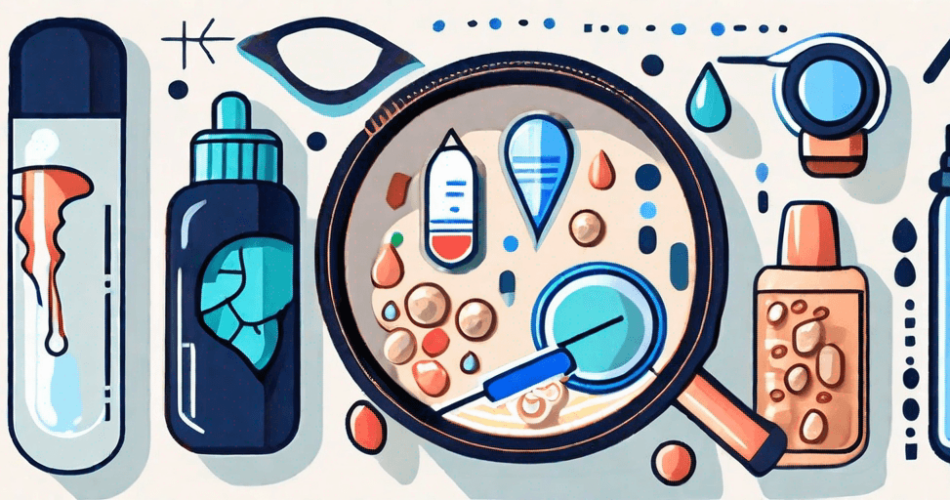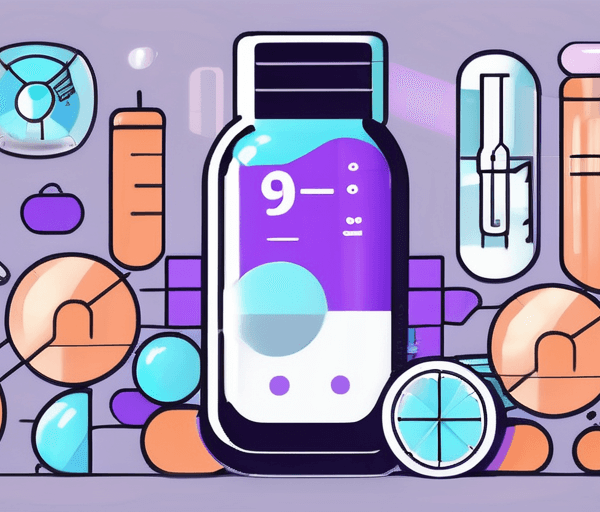Having a chronic condition, like diabetes can have a profound impact on the skin’s health and appearance. Unfortunately, skin health and its connection to diabetes is often overlooked. In this article, delve into the common condition associations, and discover signs of diabetes on the skin. Let’s uncover how it can help improve one’s health and be its basis for an appropriate treatment plan.
Understanding the Connection Between Skin Health and Diabetes

Before delving into specific skin conditions associated with diabetes, it is crucial to grasp the underlying connection between diabetes and skin health. The key player in this relationship is the hormone insulin. Insulin, produced by the pancreas, regulates the metabolism of carbohydrates and glucose in the body. For patients with diabetes, insulin is either insufficiently produced or not utilized effectively, leading to high blood sugar levels.
Additionally, diabetes often impairs the immune system, making individuals more susceptible to infections. These factors contribute to a wide range of skin issues that can significantly impact an individual’s quality of life.
The Role of Insulin in Skin Health
Insulin plays a crucial role in maintaining the health and functioning of the skin. It aids in the production of collagen, a protein that provides structural support and strength to the skin. Collagen is responsible for maintaining the skin’s elasticity, reducing the risk of wrinkles and sagging.
Moreover, insulin helps regulate the activity of sebaceous glands, which are responsible for producing sebum, the skin’s natural oil. Balanced sebum production ensures adequate hydration and prevents dryness, flakiness, and irritation.
Insulin also influences the growth and development of skin cells, ensuring proper turnover and regeneration. The lack of insulin or its impaired function disrupts these processes, leading to various skin problems.
How Diabetes Affects the Skin

Diabetes can manifest in several ways on the skin, causing a range of conditions. Understanding these conditions is essential for recognizing warning signs and seeking timely medical assistance.
Individuals with diabetes may experience blisters due to the condition. These blisters are typically painless and occur on the backs of the fingers, hands, toes, feet, and sometimes on the legs or forearms.
Furthermore, individuals with diabetes are prone to developing skin infections, such as styes, boils, and carbuncles. These infections occur when bacteria enter the skin through a break or cut and can be challenging to treat due to the compromised immune system.
Other skin conditions associated with diabetes include digital sclerosis, which causes the skin on the hands, fingers, and toes to become thick and waxy, and eruptive xanthomatosis, which presents as firm, yellow, pea-like bumps on the skin.
It is important for individuals with diabetes to pay close attention to their skin health and seek medical advice if they notice any changes or abnormalities.
Common Skin Conditions Associated with Diabetes

A chronic condition like diabetes affects various parts of the body, including the skin. Individuals with diabetes are prone to developing certain skin conditions that may require attention and management. Understanding these conditions can help individuals with diabetes take proactive measures to maintain healthy skin.
Diabetic Dermopathy
One of the most common skin conditions associated with diabetes is diabetic dermopathy. This condition manifests as light brown or reddish, scaly patches, usually found on the shins. These patches are typically harmless and painless, but they may occasionally itch. Diabetic dermopathy is more prevalent in individuals with long-standing diabetes and primarily affects adults.
Although the exact cause of diabetic dermopathy is unknown, it is believed to be related to changes in the blood vessels that supply the skin. Proper blood sugar control and regular skincare can help manage this condition and prevent further complications.
Necrobiosis Lipoidica Diabeticorum
Another skin condition commonly seen in individuals with diabetes is necrobiosis lipoidica diabeticorum. This condition presents as yellowish or reddish-brown patches that often appear shiny and slightly depressed. Over time, these patches can develop into open sores, leaving them vulnerable to infections.
Necrobiosis lipoidica diabeticorum primarily affects the lower legs but can occur elsewhere on the body. It is more common in individuals with poorly controlled diabetes and those who have had the condition for an extended period. Proper wound care and blood sugar management are crucial in preventing complications associated with this condition.
Acanthosis Nigricans
Acanthosis nigricans is a skin condition characterized by dark, thickened, and velvety patches of skin. These patches commonly occur in body folds, such as the armpits, neck, and groin. Acanthosis nigricans often develops in individuals who are overweight or have insulin resistance, both of which are common in people with type 2 diabetes.
The exact cause of acanthosis nigricans is not fully understood, but it is believed to be related to insulin resistance. Managing blood sugar levels and maintaining a healthy weight can help improve this condition. In some cases, treating the underlying insulin resistance may lead to a reduction in the severity of acanthosis nigricans.
It is important for individuals with diabetes to be vigilant about their skin health. Regularly checking the skin for any changes, practicing good hygiene, and moisturizing regularly can help prevent and manage these skin conditions. Additionally, maintaining a healthy lifestyle, including a balanced diet and regular exercise, can contribute to overall skin health and reduce the risk of developing complications associated with diabetes.
Warning Signs of Diabetes on the Skin

Aside from knowing the skin conditions that a diabetic patient might have, it is also a crucial to understand the possible signs included. Being aware of the warning signs is essential for early detection and proper management. Paying attention to changes in your skin can provide valuable insights into your overall health. Let’s uncover each of the warning signs below!
Skin Discoloration
One of the earliest warning signs of diabetes-related skin issues is discoloration. Changes in skin pigmentation, such as darkening or lightening of certain areas, may indicate underlying diabetic dermopathy or acanthosis nigricans. Diabetic dermopathy is characterized by small, brown patches that often appear on the shins. Acanthosis nigricans, on the other hand, presents as dark, velvety patches in body folds and creases.
While these skin discolorations may not cause any physical discomfort, they serve as visible markers of underlying metabolic changes. Monitoring these changes closely and consulting a healthcare professional is crucial for early diagnosis and appropriate management.
Itching and Dryness
Diabetes can lead to dry and itchy skin due to impaired circulation and inadequate moisture retention. Excessive dryness may worsen existing skin conditions or lead to cracking and more severe complications like diabetic foot ulcers. Itching can be particularly bothersome and affect one’s quality of life.
Regular moisturization is essential to help alleviate dryness and itchiness. Using gentle, fragrance-free moisturizers and avoiding harsh soaps can help maintain the skin’s natural moisture barrier. However, it’s important to seek medical advice for persistent itching, as it may indicate an underlying skin condition that requires specific treatment.
Skin Infections
Individuals with diabetes are more susceptible to skin infections due to compromised immune function and elevated blood sugar levels. Bacterial and fungal infections, such as cellulitis and fungal nail infections, may manifest as redness, swelling, warmth, or discharge.
Cellulitis is a bacterial skin infection that can occur when bacteria enter through a break in the skin. It often presents as a painful, swollen area that may be accompanied by fever. Fungal nail infections, on the other hand, can cause thickened, discolored nails that may become brittle or crumble.
Prompt medical intervention is vital to prevent the spread of infection and potential complications. Treatment may involve antibiotics for bacterial infections and antifungal medications for fungal infections. Proper foot care and hygiene, such as keeping the feet clean and dry, can also help reduce the risk of skin infections in individuals with diabetes.
Remember, the skin is the body’s largest organ, and changes in its appearance and condition can provide valuable insights into your overall health. If you notice any unusual skin changes or have concerns about your skin health, it’s important to consult a healthcare professional for proper evaluation and guidance.
Prevention and Treatment of Skin Conditions in Diabetics

Staying ahead of the game means you understand the complexities of the condition. Diabetes, a chronic condition that affects millions of people worldwide should be addressed head on. That means, a patient must be aware of the possible prevention steps to do to minimize the risk of this illness. Thus, ensuring a healthy skin and overall well being.
Skin Care Tips for Diabetics
Proper skin care practices play a significant role in preventing and managing skin conditions in individuals with diabetes. Here are some essential tips:
- Keep the skin clean and dry, paying particular attention to folds and areas prone to sweat accumulation. This includes areas such as the armpits, groin, and under the breasts.
- Use mild, hypoallergenic cleansers and moisturizers to maintain adequate skin hydration. Avoid products with harsh chemicals or fragrances that can further irritate the skin.
- Avoid hot water during bathing and opt for lukewarm water instead. Hot water can strip the skin of its natural oils, leading to dryness and irritation.
- Wear loose-fitting, breathable clothing to allow proper air circulation and prevent skin irritations. Tight clothing can rub against the skin and cause friction, leading to skin breakdown.
- Inspect your skin regularly for changes, and seek medical advice promptly if any concerns arise. Early detection of skin issues can prevent them from worsening and becoming more difficult to manage.
When to Seek Medical Help
While preventive measures and self-care play a critical role in managing diabetes-related skin conditions, it is vital to seek medical assistance when necessary. Dermatologists and healthcare professionals experienced in diabetes care can provide essential guidance, diagnosis, and treatment options tailored to individual needs.
Thus, individuals with diabetes should promptly consult a healthcare professional if they experience persistent skin discoloration, itching, dryness, or any signs of infection. Early intervention can prevent the progression of skin complications, ensure optimal skin health, and contribute to overall well-being.
Final Takeaway
Understanding the connection between diabetes and skin health is crucial for maintaining optimal well-being. Diabetes can significantly impact the skin, resulting in various skin complications in the different parts of the body. That’s why, learning the signs of diabetes on the skin can be beneficial in terms of planning the next best step for combating diabetes. Thus, pushing the patient to be one step closer to feeling healthy.
Knowledge is key when it comes to achieving a healthier state of the body. Set a consultation with an expert to ensure wellness today!



